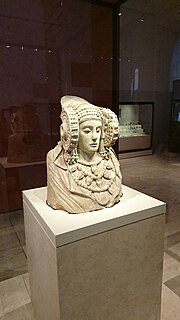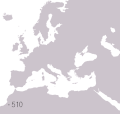The history of ancient Iberian coinage begins as early as the fifth century BC, but widespread minting and circulation in the Iberian peninsula did not...
26 KB (2,654 words) - 05:19, 1 June 2023
The history of ancient Greek coinage can be divided (along with most other Greek art forms) into four periods: the Archaic, the Classical, the Hellenistic...
32 KB (3,066 words) - 10:37, 10 December 2023
The Iberians (Latin: Hibērī, from Greek: Ἴβηρες, Iberes) were an ancient people settled in the eastern and southern coasts of the Iberian peninsula, at...
31 KB (3,752 words) - 04:34, 3 June 2024
Roman currency (redirect from Ancient Roman coinage)
Roman history consisted of gold, silver, bronze, orichalcum and copper coinage. From its introduction during the Republic, in the third century BC, through...
30 KB (3,715 words) - 01:23, 20 April 2024
Sasanian coinage Sasanian coinage was produced within the domains of the Iranian Sasanian Empire (224–651). Together with the Roman Empire, the Sasanian...
24 KB (2,353 words) - 00:53, 20 May 2024
Celtiberians (redirect from Celt-Iberian)
and Celticized peoples inhabiting an area in the central-northeastern Iberian Peninsula during the final centuries BC. They were explicitly mentioned...
23 KB (2,824 words) - 01:03, 21 February 2024
rich in wines, a character which it still preserves. Via Augusta Ancient Iberian coinage Archeological Museum of Seville Plin. iii. 1. s. 3. Dyer 1857,...
3 KB (136 words) - 00:44, 13 October 2023
Greeks in pre-Roman Gaul (redirect from Massalian coinage)
traded as least as far as Gades and Tartessus on the western coast of the Iberian peninsula, as described in the Massaliote Periplus, although this trade...
21 KB (2,244 words) - 23:09, 20 August 2023
Celts (redirect from Ancient Celt)
Higher-value coinages, suitable for use in trade, were minted in gold, silver, and high-quality bronze. Gold coinage was much more common than silver coinage, despite...
146 KB (16,575 words) - 12:40, 17 May 2024
Syracuse in 878, Constantinople became the sole mint for gold and silver coinage until the late 11th century, when major provincial mints began to re-appear...
19 KB (1,957 words) - 21:42, 22 March 2024
rulers of most of the Iberian peninsula. The resulting state survived until the Islamic invasion of 711. In the study of the coinage of the Visigoths a different...
28 KB (3,559 words) - 20:44, 24 February 2024
Silver coin (redirect from Silver coinage)
form of coinage. Silver has been used as a coinage metal since the times of the Greeks; their silver drachmas were popular trade coins. The ancient Persians...
22 KB (2,911 words) - 07:05, 20 February 2024
Near East, inspired developments in art and architecture, the adoption of coinage, and the development of the Greek alphabet. Athens developed its democratic...
79 KB (9,321 words) - 19:29, 1 June 2024
ownership. Although barter was used in ancient Rome, and often used in tax collection, Rome had a very developed coinage system, with brass, bronze, and precious...
186 KB (21,223 words) - 23:44, 27 May 2024
Tarraco (category Iberians)
Tarraco is the ancient name of the current city of Tarragona (Catalonia, Spain). It was the oldest Roman settlement on the Iberian Peninsula. It became...
15 KB (1,708 words) - 15:34, 15 January 2024
powerful navies in the ancient Mediterranean, and an army composed heavily of foreign mercenaries and auxiliaries, particularly Iberians, Balearics, Gauls...
198 KB (24,380 words) - 02:50, 27 May 2024
Arganthonios (category Articles containing Ancient Greek (to 1453)-language text)
Gargoris and Habis, Arganthonios is the earliest documented monarch of the Iberian Peninsula. According to the Greek historian Herodotus, King Arganthonios...
5 KB (498 words) - 16:54, 19 February 2024
Tigranes I (category Articles containing Ancient Greek (to 1453)-language text)
Tigranes I (Ancient Greek: Τιγράνης) was an Artaxiad king of Armenia at the end of the 2nd and the beginning of the 1st century BC. Few records have survived...
22 KB (2,045 words) - 07:03, 22 April 2024
Antoninianus (category Coins of ancient Rome)
(ed.). The Oxford handbook of Greek and Roman coinage. New York: Oxford University Press. p. 507. "Ancient Coins – Roman Silver Antoninianus". www.24carat...
5 KB (536 words) - 10:40, 29 December 2023
Roman economy (redirect from Economy of Ancient Rome)
"Trade," in CAH 11, pp. 717–729. Mireille Corbier, "Coinage, Society, and Economy," in Cambridge Ancient History: The Crisis of Empire, A.D. 193–337 (Cambridge...
62 KB (7,320 words) - 21:51, 1 April 2024
The Muslim conquest of the Iberian Peninsula (Arabic: فَتْحُ الأَنْدَلُس), also known as the Arab conquest of Spain, by the Umayyad Caliphate occurred...
40 KB (5,130 words) - 23:21, 1 June 2024
Modern influence of ancient Greece refers to the influence of Ancient Greece on later periods of history, from Medieval times up to the current modern...
125 KB (14,771 words) - 03:09, 27 April 2024
Greek colonisation (redirect from Colonies of ancient Greece)
colonists from Issa. The artifact is known as Lumbarda Psephisma. Evidence of coinage on the Illyrian coast used for trade between the Illyrians and the Greeks...
54 KB (4,713 words) - 09:39, 26 May 2024
Hēmeroskopeion (category Articles containing Ancient Greek (to 1453)-language text)
speculation that the term Dianio stemmed from an Iberian settlement named Diniu, which was supported by certain coinage discoveries. However, this has been identified...
9 KB (1,014 words) - 08:43, 13 December 2023
Empúries (category Articles containing Ancient Greek (to 1453)-language text)
(Greeks) predominated while a third of burials were cremations (Iberians). The ancient necropolis remained in use with inhumations and cremations, possibly...
15 KB (1,562 words) - 10:40, 8 March 2024
Cheste hoard (category Iberian art)
silver that were used as bullion and commonly found in Iberian hoards from this period. Unlike coinage, hacksilber was not controlled by the state, and could...
4 KB (464 words) - 22:43, 26 September 2023
Duchess of Medina Sidonia (born 1936). This city was most likely ancient Asido, an Iberian settlement which may have been founded by the Phoenicians, hence...
6 KB (627 words) - 17:35, 30 May 2024
Huesca (category Articles containing Ancient Greek (to 1453)-language text)
base. The city minted its own coinage and was the site of a prestigious school founded by Sertorius to educate young Iberians in Latin and Roman customs...
26 KB (2,445 words) - 21:23, 11 May 2024
Roman Empire (redirect from Ancient Roman Empire)
The Roman Empire was the post-Republican state of ancient Rome. It is generally understood to mean the period and territory ruled by the Romans following...
248 KB (28,043 words) - 17:05, 30 May 2024
A client kingdom or people in ancient Rome meant a kingdom or ancient people that was in the condition of "appearing" still independent, but in the "sphere...
67 KB (7,358 words) - 19:14, 8 March 2024



























